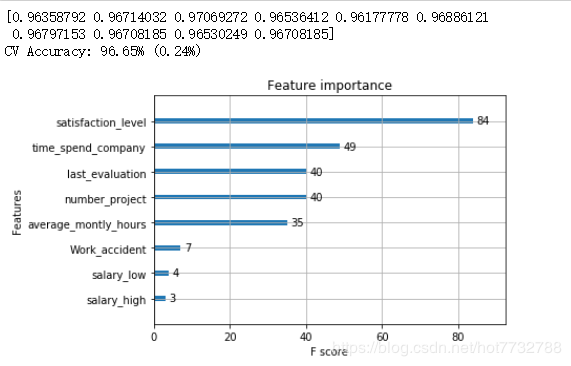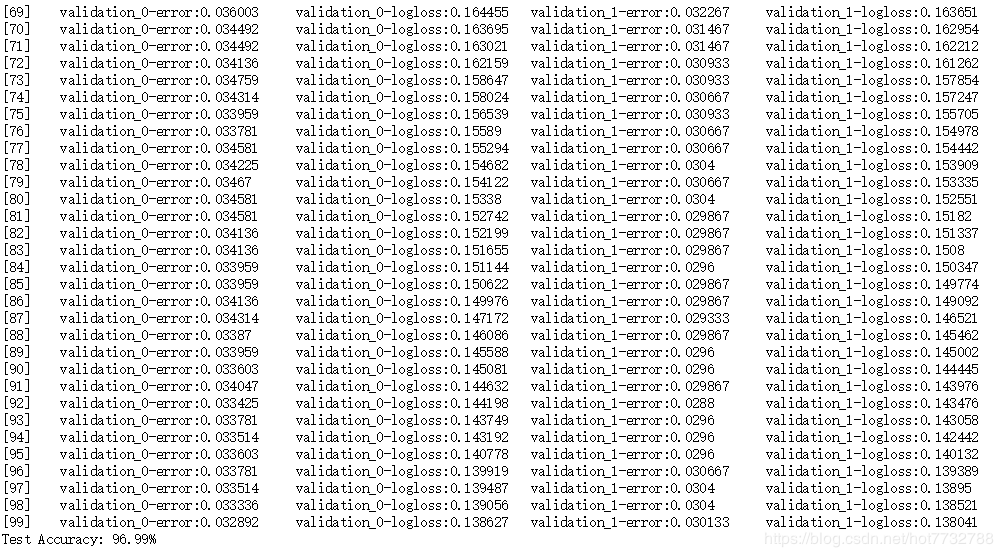溫馨提示×
您好,登錄后才能下訂單哦!
點擊 登錄注冊 即表示同意《億速云用戶服務條款》
您好,登錄后才能下訂單哦!
小編給大家分享一下python中xgboost怎么用,相信大部分人都還不怎么了解,因此分享這篇文章給大家參考一下,希望大家閱讀完這篇文章后大有收獲,下面讓我們一起去了解一下吧!
1.數據讀取
利用原生xgboost庫讀取libsvm數據
import xgboost as xgb data = xgb.DMatrix(libsvm文件)
使用sklearn讀取libsvm數據
from sklearn.datasets import load_svmlight_file X_train,y_train = load_svmlight_file(libsvm文件)
使用pandas讀取完數據后在轉化為標準形式
2.模型訓練過程
1.未調參基線模型
使用xgboost原生庫進行訓練
import xgboost as xgb
from sklearn.metrics import accuracy_score
dtrain = xgb.DMatrix(f_train, label = l_train)
dtest = xgb.DMatrix(f_test, label = l_test)
param = {'max_depth':2, 'eta':1, 'silent':0, 'objective':'binary:logistic' }
num_round = 2
bst = xgb.train(param, dtrain, num_round)
train_preds = bst.predict(dtrain)
train_predictions = [round(value) for value in train_preds] #進行四舍五入的操作--變成0.1(算是設定閾值的符號函數)
train_accuracy = accuracy_score(l_train, train_predictions) #使用sklearn進行比較正確率
print ("Train Accuary: %.2f%%" % (train_accuracy * 100.0))
from xgboost import plot_importance #顯示特征重要性
plot_importance(bst)#打印重要程度結果。
pyplot.show()使用XGBClassifier進行訓練
# 未設定早停止, 未進行矩陣變換
from xgboost import XGBClassifier
from sklearn.datasets import load_svmlight_file #用于直接讀取svmlight文件形式, 否則就需要使用xgboost.DMatrix(文件名)來讀取這種格式的文件
from sklearn.metrics import accuracy_score
from matplotlib import pyplot
num_round = 100
bst1 =XGBClassifier(max_depth=2, learning_rate=1, n_estimators=num_round, #弱分類樹太少的話取不到更多的特征重要性
silent=True, objective='binary:logistic')
bst1.fit(f_train, l_train)
train_preds = bst1.predict(f_train)
train_accuracy = accuracy_score(l_train, train_preds)
print ("Train Accuary: %.2f%%" % (train_accuracy * 100.0))
preds = bst1.predict(f_test)
test_accuracy = accuracy_score(l_test, preds)
print("Test Accuracy: %.2f%%" % (test_accuracy * 100.0))
from xgboost import plot_importance #顯示特征重要性
plot_importance(bst1)#打印重要程度結果。
pyplot.show()2.兩種交叉驗證方式
使用cross_val_score進行交叉驗證
#利用model_selection進行交叉訓練
from xgboost import XGBClassifier
from sklearn.model_selection import StratifiedKFold
from sklearn.model_selection import cross_val_score
from sklearn.metrics import accuracy_score
from matplotlib import pyplot
param = {'max_depth':2, 'eta':1, 'silent':0, 'objective':'binary:logistic' }
num_round = 100
bst2 =XGBClassifier(max_depth=2, learning_rate=0.1,n_estimators=num_round, silent=True, objective='binary:logistic')
bst2.fit(f_train, l_train)
kfold = StratifiedKFold(n_splits=10, random_state=7)
results = cross_val_score(bst2, f_train, l_train, cv=kfold)#對數據進行十折交叉驗證--9份訓練,一份測試
print(results)
print("CV Accuracy: %.2f%% (%.2f%%)" % (results.mean()*100, results.std()*100))
from xgboost import plot_importance #顯示特征重要性
plot_importance(bst2)#打印重要程度結果。
pyplot.show()
使用GridSearchCV進行網格搜索
#使用sklearn中提供的網格搜索進行測試--找出最好參數,并作為默認訓練參數
from xgboost import XGBClassifier
from sklearn.model_selection import GridSearchCV
from sklearn.metrics import accuracy_score
from matplotlib import pyplot
params = {'max_depth':2, 'eta':0.1, 'silent':0, 'objective':'binary:logistic' }
bst =XGBClassifier(max_depth=2, learning_rate=0.1, silent=True, objective='binary:logistic')
param_test = {
'n_estimators': range(1, 51, 1)
}
clf = GridSearchCV(estimator = bst, param_grid = param_test, scoring='accuracy', cv=5)# 5折交叉驗證
clf.fit(f_train, l_train) #默認使用最優的參數
preds = clf.predict(f_test)
test_accuracy = accuracy_score(l_test, preds)
print("Test Accuracy of gridsearchcv: %.2f%%" % (test_accuracy * 100.0))
clf.cv_results_, clf.best_params_, clf.best_score_3.早停止調參–early_stopping_rounds(查看的是損失是否變化)
#進行提早停止的單獨實例
import xgboost as xgb
from xgboost import XGBClassifier
from sklearn.metrics import accuracy_score
from matplotlib import pyplot
param = {'max_depth':2, 'eta':1, 'silent':0, 'objective':'binary:logistic' }
num_round = 100
bst =XGBClassifier(max_depth=2, learning_rate=0.1, n_estimators=num_round, silent=True, objective='binary:logistic')
eval_set =[(f_test, l_test)]
bst.fit(f_train, l_train, early_stopping_rounds=10, eval_metric="error",eval_set=eval_set, verbose=True) #early_stopping_rounds--當多少次的效果差不多時停止 eval_set--用于顯示損失率的數據 verbose--顯示錯誤率的變化過程
# make prediction
preds = bst.predict(f_test)
test_accuracy = accuracy_score(l_test, preds)
print("Test Accuracy: %.2f%%" % (test_accuracy * 100.0))4.多數據觀察訓練損失
#多參數順
import xgboost as xgb
from xgboost import XGBClassifier
from sklearn.metrics import accuracy_score
from matplotlib import pyplot
num_round = 100
bst =XGBClassifier(max_depth=2, learning_rate=0.1, n_estimators=num_round, silent=True, objective='binary:logistic')
eval_set = [(f_train, l_train), (f_test, l_test)]
bst.fit(f_train, l_train, eval_metric=["error", "logloss"], eval_set=eval_set, verbose=True)
# make prediction
preds = bst.predict(f_test)
test_accuracy = accuracy_score(l_test, preds)
print("Test Accuracy: %.2f%%" % (test_accuracy * 100.0))
5.模型保存與讀取
#模型保存
bst.save_model('demo.model')
#模型讀取與預測
modelfile = 'demo.model'
# 1
bst = xgb.Booster({'nthread':8}, model_file = modelfile)
# 2
f_test1 = xgb.DMatrix(f_test) #盡量使用xgboost的自己的數據矩陣
ypred1 = bst.predict(f_test1)
train_predictions = [round(value) for value in ypred1]
test_accuracy1 = accuracy_score(l_test, train_predictions)
print("Test Accuracy: %.2f%%" % (test_accuracy1 * 100.0))以上是“python中xgboost怎么用”這篇文章的所有內容,感謝各位的閱讀!相信大家都有了一定的了解,希望分享的內容對大家有所幫助,如果還想學習更多知識,歡迎關注億速云行業資訊頻道!
免責聲明:本站發布的內容(圖片、視頻和文字)以原創、轉載和分享為主,文章觀點不代表本網站立場,如果涉及侵權請聯系站長郵箱:is@yisu.com進行舉報,并提供相關證據,一經查實,將立刻刪除涉嫌侵權內容。